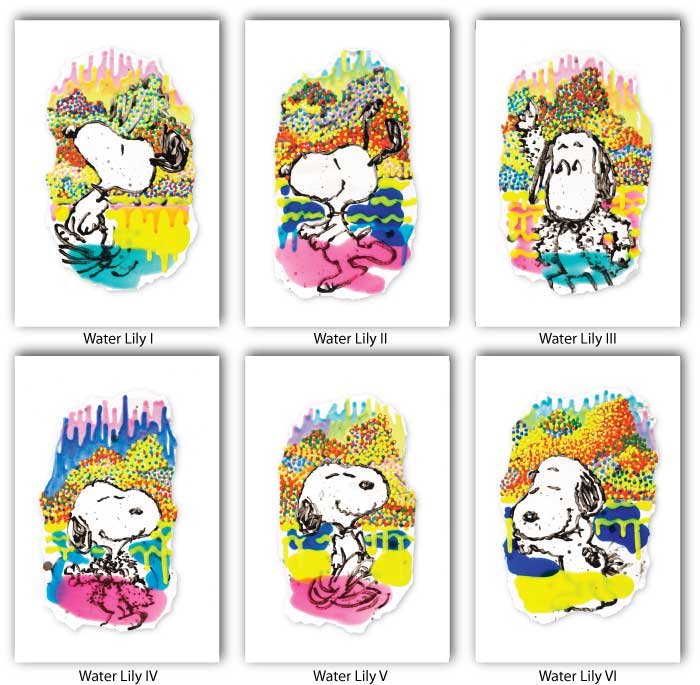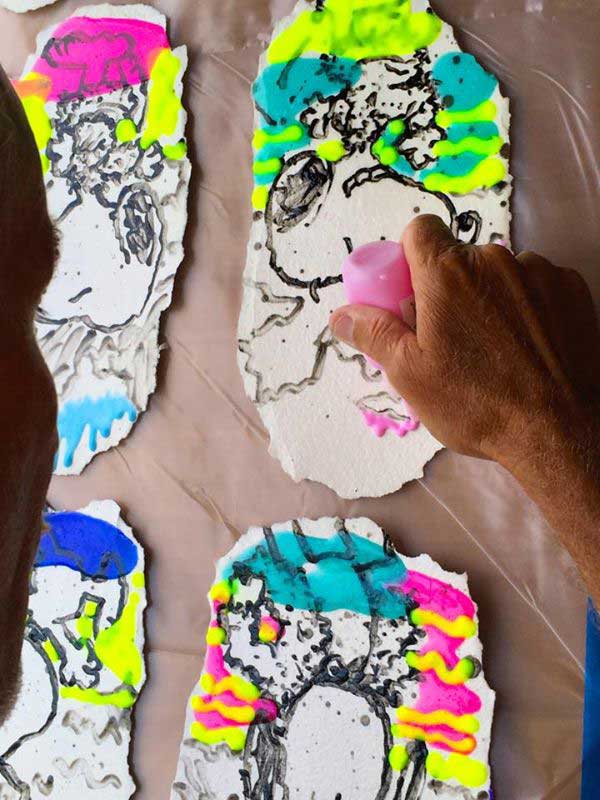|
Tom Everhart
Water Lilies

I was not led to retreat to Tahiti, in 2000, and begin a second home / studio, to leave my way of seeing, but to test it. Although, because it was the same year that Sparky (Charles M. Schulz) died, I would be intellectually dishonest to not admit to it somewhat. Mostly, it was if this influential volume of unique line constructions, that Sparky allowed me to check out of his visual library, would work in a Tahitian environment, were life is lived and has lived so differently. The visual test would play out in a succession of “series”.
The “Water Lilies” series was produced in the Tahitian studio during the same period of time that, in the Venice studio, the “I’ve Got Ants In My Pants (and I need to dance)” series was in production, and was meant to be a tributary of it. The “I’ve Got Ants In My Pants” series incorporated a group of dance drawings that represented the restless rhythms of the eagerness and anxiousness to make art as a direct response to something fascinating, new, beautiful, or even something incredibly stupid. So when this group of dance drawings was transplanted into the Tahiti studio, they immediately referenced the fascinating and beautiful traditions of dance, as it is very much a party of the Tahitian culture and history, with rhythms of visual narratives that share how they see the world.
“Once the dance drawings references of Sparky’s character of Snoopy were worked into the lagoon sections of the paintings, they appeared to dance on the surface of the water much like water lilies. And that became a reference back to the “Nymphéas” of Claude Monet’s series of “Water Lilies” in the Orangerie of the Tuileries, in Paris, which had occupied much of the final year of my art academia studies. Although these eight compositions of the Orangerie had only a short direct influence on my work they became a constant source of inspiration.

Tom Everhart painting Water Lilies at his home studio in Tahiti
For example, because Monet’s “Water Lilies” constituted a “series’, a giant series of over two hundred and fifty canvases, he is the inventor of the very principle of a series. The very same principle, which has been the basic construction of my own work of the last twenty-seven years, in depicting a single visual influence in a scale of studies, each theme with its own meaning, allowing an obvious progression from one series to the next.
There is a daily series of abstractions that are produced by the refraction, reflection, and dispersion of light in rain and mist that saturates the water and land in color. We refer to it as, “rainbow fog”. In my “Water Lilies” series this extraordinary visual activity of light entirely colors the surface of the lagoon water, in which the characters dance, and the mountain peaks of the island of Bora Bora with refracted, reflected color much in the same way that Monet does in his “Nymphéas”. This is because Monet was working above all on changes in the purely physical aspect of light.
More importantly, it was his study of light that led to his importance as a theoretician of abstract art. So not only was Monet involved in the beginnings of abstract art, but also constituted, after 1950, a new wave of abstract expressionist painters who’s work made me receptive to the abstract qualities of Sparky’s visual constructions and influence.
As Kandinsky noted, after looking at Monet, he “discovered the possibility of painting without representation”.
– Tom Everhart

|

